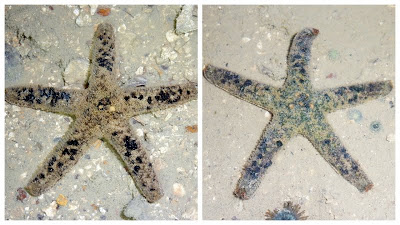After a year's wait, we are back to Beting Bronok (BB) to have a look at how it is doing. BB is a submerged reef off Pulau Tekong that will only be exposed at a good low spring tide.
The variety and abundance of marine life here beats many of our northern shores despite being hit by the mass flooding of freshwater in 2007.
See how glorious it was before that.
Here is a Pencil sea urchin (Prionocidaris sp.) with an assortment of hydroids, seaweed and sponges. Somehow, the sponge growth in general seems to have been reduced as compared to the visit from the past two years. And that the zoanthids have colonised even more of the shore. In addition, some parts of the reef seem to be more silty than before.

Nevertheless, I'm relieved that the good old Knobbly sea stars (Protoreaster nodosus) are still around. BB is probably the only northern shore with so many of these stars now.

The shore is also littered with many huge Biscuit sea stars (Gonodiscaster scaber).
There were some of these orange-tipped Spiny sea star (Gymnanthenea laevis). They look quite similar to the Cake sea star (Anthenea aspera) which I didn't get to see today though the rest did.

There were also a quite a few of these uncommon Scaly sea star (Nepanthia belcheri) which is a good sign that they are doing well on this shore.
The top echinoderm find of the day must be this rare Basket star (Family Euryalidae)! It is my third time seeing it on our intertidal, and this probably may be our first record for the northern intertidal shores.

Basket stars are rather related to our brittle stars though they have further projections coming off from their five main arms.
Tanah Merah and BB are probably the only two places where one can be quite sure to spot the Brown spotted moray eel (Gymnothorax reevesii). The few of these eels that we saw today were stranded with the outgoing tide.
Chay Hoon and Mei Lin found this lovely pair of Estuarine seahorses (Hippocampus kuda) which I have not seen in the north for some time already.
Among the seaweeds and the substrates, there were a number of octopuses that are quite active at night.
I was searching high and low for the resident Baler volutes (Melo melo) of BB until Ria saw this biggest baler volute that I've ever came across. In fact, a smaller one was clinging on the shell of the giant one!
Another feature of BB will be the variety of nudibranch or sea slugs that it houses, such are those below that I came across today:
Blue dragon (Pteraeolidia ianthina)
Rose nudibranch (Dendrodoris fumata)
Bushy slug (Polybranchia orientalis)
Bohol nudibranch (Discodoris boholiensis)

Unfortunately, the regional coral bleaching is also affecting some of the Pore corals (Porites sp.) in BB.
The Ball flowery soft corals of the eastern side of BB have all been wiped out! :(
But this photo shows one of some of those that are still thriving nearer to the west.

Sam found a couple of the Commensal snapping shrimps within the soft coral. Very cute!
During the lowest tide, some of the sea fans were exposed such as this white colony.
This orange sea fan was knocked down and I tried to reposition back into its standing position.
At the deeper ends of the murky waters are also some more of these gorgonians. They used to be very common before the mass flood of 2007.

One thing to be cautious at BB will be to wear long pants because there are tons of stinging hydroids. Even a slight brush against it with bare skin will cause an immediate fiery reaction, raising painful welts that eventually itch for a long time.
Though we cannot touch, we were looking intently at them for slugs that live among them. To our disappointment, we found none. But at least I saw this cute little shrimp!
There were many crabs on the shore but one of my favourites will be this colourful Elbow crab (Family Parthenopidae).
While James and Ivan found this Decorator crab (Camposcia retusa) that for once finally has sponge growth that matches the colour of where it was standing! Don't you think the crab fit well in the camouflage act?
Talking about sponges, I came across this sponge that can be found in the book "A guide to Sponges of Singapore" by Swee Cheng. This sponge is Terpios sp. or also known as 'roti jala'. Roti jala is a kind of malay pancake that looks like a combination of many orange threads. The description fits the irregular net-like mass of this sponge. According to Swee Cheng, this sponge is found on estaurine reefs in the Johor Straits.
Last but not least, I found this Haekel's anemone (Actinostephanus haekeli) towards the end of the trip. It was initially shrunk within its body column until the tide came in.
The trip ended with a glorious sunrise over a scenic backdrop, just like that of a typical postcard.
Though on one hand, it was a relief that the recent oil spill did not affect this shore, recovery from the mass flood seems to take longer than we hope it to be. Still, with time and zero impact, the reef will slowly regain back its former glory.
More photos of today's trip and other creatures here: http://www.flickr.com/photos/koksheng/archives/date-posted/2010/06/14/
Monday, June 14, 2010
The annual Beting Bronok checkup
Subscribe to:
Post Comments (Atom)

























3 comments:
didn't get a chance to go, but after reading your post and seeing your photos, it's like 'thanks for the dry trip!' :) my favourites are the basket star and the crabs! :)
may i know you dive or snorkeling or just reef walk?
it is a reef walk
Post a Comment